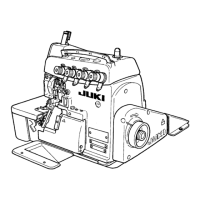
Do you have a question about the JUKI MO-6700D Series and is the answer not in the manual?
| Lubrication | Automatic |
|---|---|
| Type | Overlock Machine |
| Number of Needles | 2 |
| Number of Threads | 4 |
| Stitch Length | 1-4mm |
| Differential Feed | 0.7 - 2 |
| Max. Sewing Speed | 7000spm |
| Stitching Speed | 7000spm |
| Bobbin | None (Uses Loopers) |
| Motor | Servo Motor |
Manual for technical personnel responsible for service and maintenance of the machine.
Sets the needle height from the throat plate surface when the needle is at its highest position.
Ensures correct needle entry point distance from the throat plate slot edge.
Covers returning amount and clearance between lower looper and needle.
Details strength of tension springs and springs used for each model.
Lists specifications for the MO-6704D, MO-6714D, and MO-6716D models.
Explains the coding system used for model numbers of the MO-6700D series.
Classifies various devices and attachments for the sewing machine.
Indicates the designated place of destination for the machine.
Sets the needle height from the throat plate surface when the needle is at its highest position.
Ensures correct needle entry point distance from the throat plate slot edge.
Details how to adjust the length of the lower looper holder.
Covers returning amount and clearance between lower looper and needle.
Explains the vertical and lateral positioning of the upper looper guide.
Details how to adjust the distance for the upper looper holder.
Sets the distance between the throat plate and the upper looper blade point.
Covers returning amount, longitudinal motion, and clearance of the double chain looper.
Details height and clearance adjustments for needle guards on different machine types.
Specifies the height of the main and auxiliary feed dogs relative to the throat plate.
Explains how to adjust the tilt of the feed dogs for proper material feeding.
Details the adjustment of the differential feed ratio for gathering and stretching.
Covers adjusting the tilt and micro-lifting mechanism of the presser foot.
Explains positioning of knives and adjustment of overedging width.
Provides guidance on resharpening the lower knife and replacing the upper knife.
Details adjustment of the thread cam and related guides/nails.
Details adjustment of the thread cam and related guides/nails.
Explains how to adjust the auxiliary thread take-up lever for specific models.
Ensures uniform contact of the throat plate support with the throat plate.
Ensures the looper cover closes smoothly without contacting the upper knife.
Details strength of tension springs and springs used for each model.
Provides information on selecting and using the correct upper looper.
Provides guidance on applying sealant and other assembly precautions.
Lists types of motor pulleys, belts, and frame support plate bolts.
Provides adjustment values for needle height and upper/lower looper components for specific machine types.
Lists causes and corrective measures for needle thread breakage.
Provides dimensions for the semi-sunken table type.